The Intel Core i7-12700K and Core i5-12600K Review: High Performance For the Mid-Range
by Gavin Bonshor on March 29, 2022 8:00 AM ESTCPU Benchmark Performance: Power, Office, and Science
Our previous set of ‘office’ benchmarks have often been a mix of science and synthetics, so this time we wanted to keep our office section purely on real-world performance.
For the remainder of the testing in this review of the Core i7-12700K and i5-12600K, we are using DDR5 memory at the following settings:
- DDR5-4800(B) CL40
Power
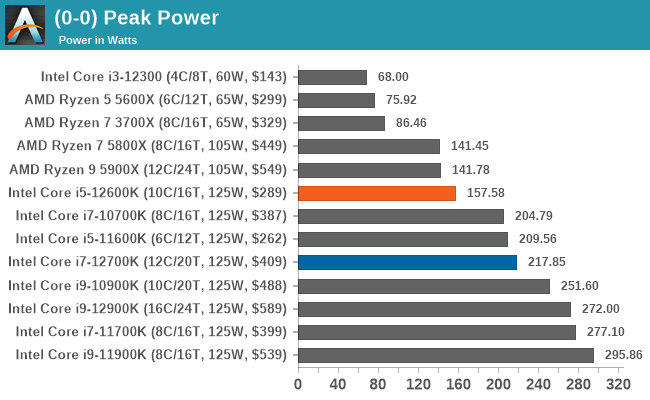
Comparing power draw to other competing CPUs, both the Core i7-12700K and Core i5-12600K are noticeably more power-efficient than previous generations including both Intel's 11th Gen and 10th Gen Core. Though at full-load with no overclocking, AMD's Ryzen 5000 and 3000 series processors remain much more power-efficient.
Office
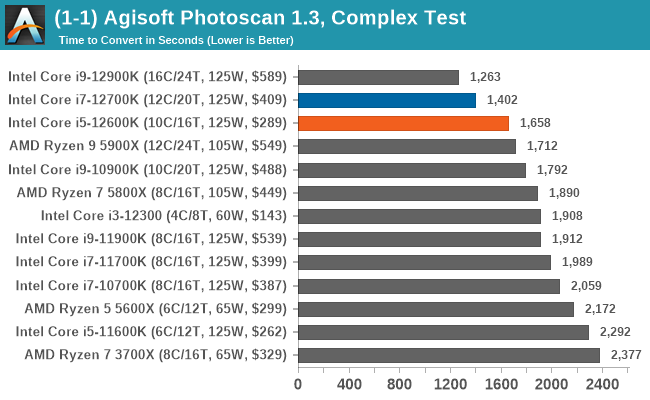
In our office benchmarks, Intel's 12th Gen Core reigns supreme in Agisoft Photoscan due to its higher core frequency and IPC performance.
Science
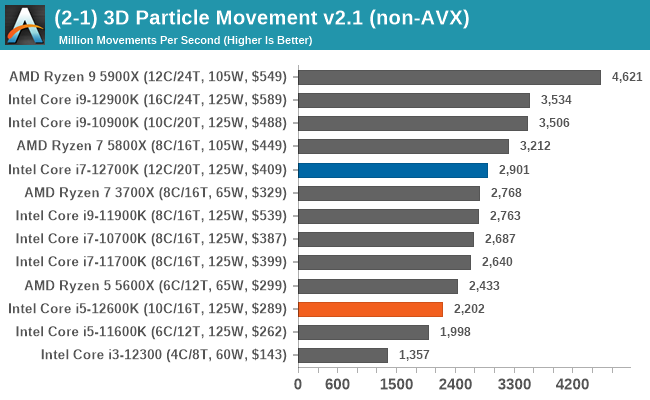
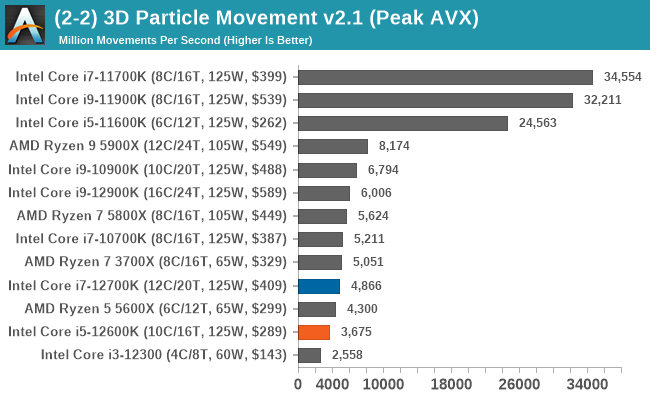

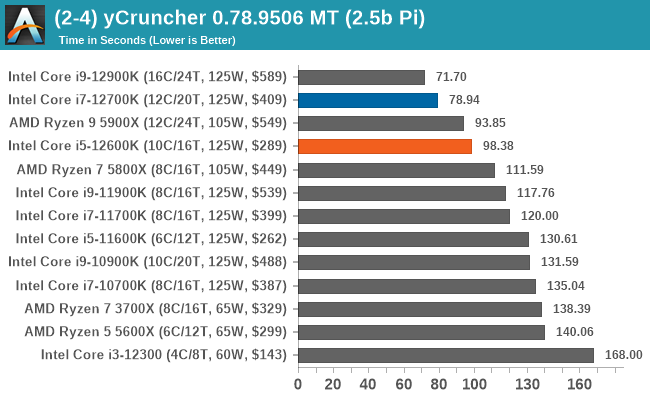
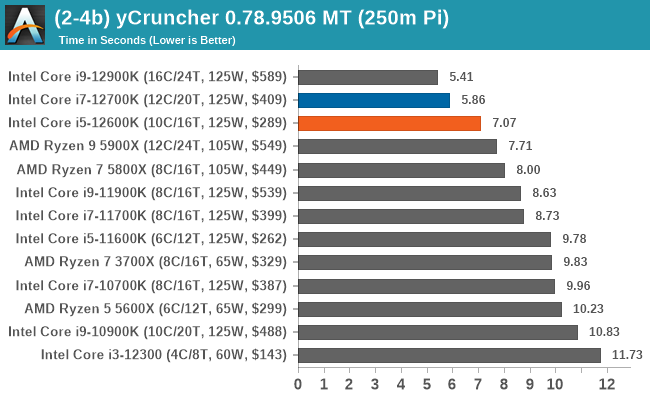
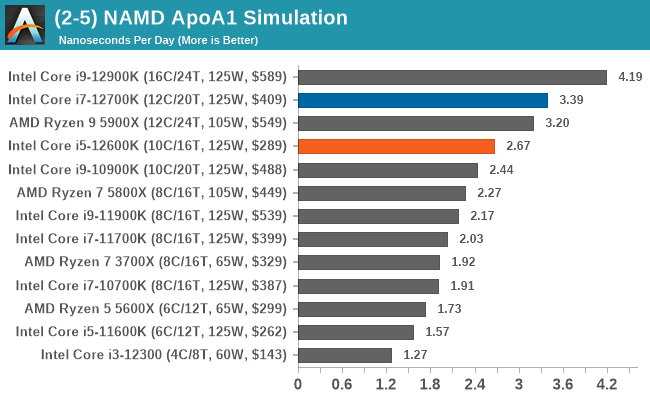
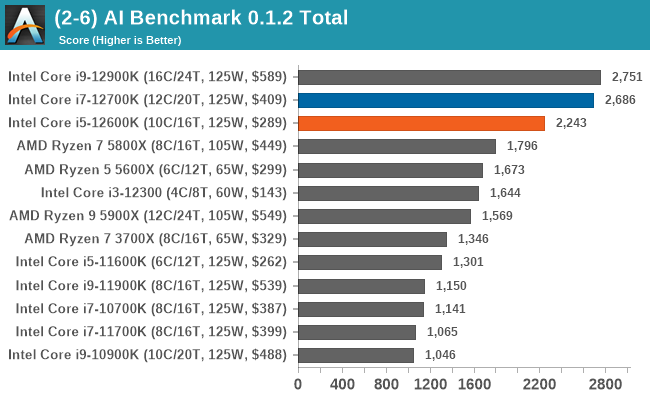
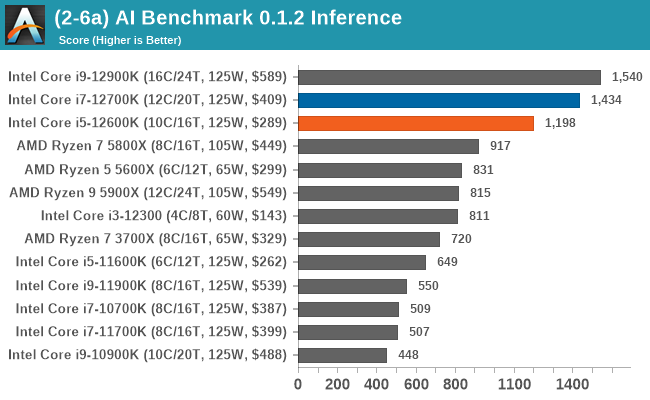
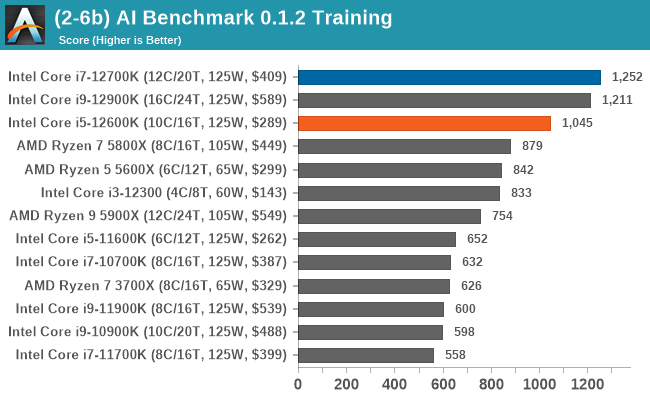
In the majority of our science-based benchmarks, both the Core i7 and Core i5 did well. The only benchmarks that didn't favor the 12th Gen Core series processors were in 3DPM 2.1, but more specifically in the AVX test.










196 Comments
View All Comments
mode_13h - Sunday, April 3, 2022 - link
> looking at my own decompiled codeThis is a bad way to judge performance. You should use profiling tools like VTune to know how much runtime is spent in the FP-heavy code, because that's what counts.
> I'd be highly surprised if the integer side isn't the critical path most of the time.
I'm sure it depends a lot on the type of game and the game engine being used.
Dolda2000 - Sunday, April 3, 2022 - link
Well, certainly, running objdump was just easier in order to type up a comment, but looking at a Linux perf recording of a typical run certainly also doesn't reveal a single FP-heavy function at the top of the heatmap.mode_13h - Monday, April 4, 2022 - link
> looking at a Linux perf recording of a typical runYou mean operf?
When profiling optimized code with any tool, you obviously want to keep in mind that inlining can cause some functions either to vanish or seem to have a lot less footprint than they actually do.
Spunjji - Friday, April 1, 2022 - link
"Thuban was a better design, so updating the instruction set would have made a better product than bulldozer."False. Thuban hit a hard clock limit and it was never very competitive with Core.
If you're going to blame AMD for Intel's abuse of their dominant position because AMD didn't compete, you kinda have to blame Intel for staving AMD of cash when they had better designs, leading to the abd decisions that resulted in Bulldozer...
Qasar - Friday, April 1, 2022 - link
i have seen comments from some that if intel didnt stagnate the market, and stick the mainstream with 4 cores, for all those years before zen was released, it would of put amd out of business.eek2121 - Saturday, April 2, 2022 - link
You have 'seen' correctly. If Intel had kept innovating, AMD would not exist right now. They didn't, so AMD not only exists, but is stealing their breakfast and lunch money. Intel can only keep losing until they address the biggest elephant in the room: efficiency. Using 241W to beat a CPU that consumes half the power isn't efficient.Qasar - Saturday, April 2, 2022 - link
eek2121, sure we " could " say that now, but in the end, NO one knows 100% for sure. i have seen some very heated debates on this as well. one person even said, intel did this, just so it wouldnt put amd out of business. yea right, since when has intel ever done anything for the benefit of others.Khanan - Thursday, April 7, 2022 - link
Eh nonsense. AMD kept itself alive by pushing console APUs and even if Intel would’ve stayed ahead they could’ve made money with CPUs on desktop anyway.mode_13h - Saturday, April 2, 2022 - link
> if intel didnt stagnate the market, and stick the mainstream with 4 cores,> for all those years before zen was released, it would of put amd out of business.
I really wanted the FTC to break up Intel, forcing it to spin out its fabs. The FTC has done things like this, in the past, but not recently. Judging by how competitive the CPU market became when TSMC caught up with Intel, I think the whole industry would've benefited.
Mike Bruzzone - Tuesday, April 5, 2022 - link
@mode_13thIf Intel were to spin out or off fabs they're different approaches, the fabs (as some financial analysts illogically proposed as financial analysis, more like shills for some institutional investment think seller houses like vultures) Intel would collapse under the weight of its own cost structure built around those fabs, a 30 year monopoly cost structure is difficult to fuel when chopped off from its multiple heads think Hydra. Removing the kilns from design production would devastate the design and manufacturing side simultaneously in relation to the on waiting competitors. The cause is Intel structural elephantiasis, having to sustain the costs of historically a monopoly structure before fully cost optimizing, pulling out the unnecessary costs, tied to that x2 to x3 processor production volume over annual computer 'real time demanded volume' to pay for Moore's Law. AND now 2.5 full node cycles across so said 5 nodes (its really 2.5) in 4 years its going to be interesting to watch from an enterprise cost : price / margin perspective.
Spinning out the fabs would be too great for Intel as an enterprise, less fabrication, and the Intel house of cards, the current structure on its maintenance cost weight, would collapse. The place would really have to be gutted, the variable cost of operations meaning people especially on the operations management side would have to be well cost back.
I'm for IFS and for Intel foundry on every attempt. Attempting to cost optimize overall enterprise structure reconfiguring for 'real time demand. Producing for real time demand verse producing for x2 to x3 MPU supply over computer demand meant by Intel to pay for Rocks CapEx doubling law while simultaneously holding channels financially tied up with Intel processor surplus production 'weight'.
Spinning out presumes sale. Spinning off does not necessarily presume sale of the fabs. One spin off option it to federate the various fabs, placing each on its own balance sheet and enabling more autonomy over what type of products each decides to produce which of course is what they're good at technically, economically and in terms of profitably. Under this federated model, none would walk away from Intel Conglomerate (think ARM Holdings) model on existing processor volume none would walk away from that volume at least for the near term.
Under a federated model and decision making is already that way currently, more or less, every fab now operates on it own balance sheet opening to up every manufacturing division, and where Intel already has design divisions, to its own R&D and innovation and the capital markets. Where every fab operates under a federated model but still combines financially with the parent entity, Intel Conglomerate, think ITT, to chose what customer, Intel or others the fab works, what the fab will produce which again is what they're good at technically, economically and financially.
This federated 'conglomerate' model makes greater sense as IFS itself under the current whole enterprise structure becomes successful. It's an option as the dynamics of monolithic processor volumes morph into systems in package.
mb